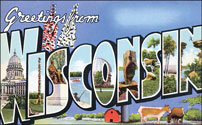6/14/09 Whats going on at the state capitol and why should you be concerned?
 On Wednesday, the Committee on Energy and Utilities will hold an executive session on AB 256 which is the bill that will strip local governments of their power to regulate the siting of wind turbines in their municipalities and give this power to three appointed members of the Public Service Commission.
On Wednesday, the Committee on Energy and Utilities will hold an executive session on AB 256 which is the bill that will strip local governments of their power to regulate the siting of wind turbines in their municipalities and give this power to three appointed members of the Public Service Commission.
[Click here to download the bill]
The Public Service Commission approved the siting of wind farms in Dodge and Fond du Lac counties which are proving to be a disaster for families whose homes are now 350 steps from industrial wind turbines that are 40 stories tall.
Six Towns in our state have adopted ordinances which, for reasons of health and safety, have setbacks of half a mile. Rather than challenging these ordinances on their merits, this bill simply overturns them and allows the PSC to site turbines as close as 1000 feet to the homes of unwilling landowners.
Please contact your legislators [click here] to let them know Assembly Bill 256 should not pass as written.
No town, village, city or county should be told to give up the right to protect and preserve the health and safety of residents from any public health impacts of an industry looking to be sited in their boundaries.
Below is the letter sent by Better Plan which addresses just one of the many concerns raised by this bill.
Dear Representative ,
As you may know, AB 256 (wind turbine siting reform) will be coming up for your vote soon.
AB 256 is missing some key checks and balances that must be corrected before this bill is passed into law.
Specifically, a local municipality must maintain the right to protect and preserve the public health and safety of its residents from public health impacts of any industry located within the boundary of the municipality.
As written, this bill removes that right and leaves nothing in its place.
An amendment is needed to preserve the right of municipalities to regulate the siting of wind turbines for reasons of public health and safety, and to establish an appeals process for aggrieved parties that goes before the Wisconsin Department of Health.
This is an issue of public health and safety and the Wisconsin Department of Health is the appropriate governing body.
An amendment is also needed to require the PSC to work with the Wisconsin Department of Health directly in order to address the issue of wind turbine impacts on public health and safety and to promulgate rules clearly supported by scientific and medical data.
A white paper issued on May 22, 2009 by the Minnesota Department of Health, Environmental Health Division, addresses Public Health Impacts of Wind Turbines and sets precedent for this.
Key Findings from the Minnesota Department of Health Report:
[click here to download full report]
--Problems with turbine noise in general, low frequency noise specifically and also trouble from shadow flicker are not a major concern at a setback of half a mile.
--There is nothing in the report which advocates a closer setback.
--Shadow flicker in homes is a bigger problem than predicted by the modeling software developers use, can last an hour and a half.
--The common calculations for predicting turbine noise are not adequate and because of this, noise levels are underestimated.
--Noise from wind turbines bothers people more quickly than noise at equal levels from traffic, planes or trains.
--The most common complaints from residents living within half mile are lack of sleep from turbine noise and also headaches. ( The report also addresses the same list of symptoms Reuters reports.)
--Turbines emit both high frequency and low frequency sounds. High frequency sounds can be lessened by walls and closed windows but low frequency sounds penetrate walls and windows easily.
The issue of wind turbine impacts on public health and safety is only just beginning to be understood and reported in the media.
“Given the mounting evidence indicating adverse effects that wind turbines can have on human health, it is critical that more research be conducted into adequate setback distances. With the emphasis that the world is placing on wind energy as a critical piece of our future energy puzzle, setback distance research would be time and money well spent to ensure that wind power grows in harmony with the environment and its citizens.”
-Reuters, June 8, 2009
Please amend the bill to include a provision that allows municipalities to retain their ability to protect the health of their residents, and provides an appellate body which is medically qualified to rule on issues of health and safety.
Click on the image below to see video from Wisconsin's newest wind farm. These setbacks were approved by the PSC. There are about 300 wind turbines currently sited in our state. The goal is to site 12,000 to 14,000 more. This means nearly every rural area in Wisconsin will be affected.